A Hydrogeologic Framework for Understanding Local Groundwater Flow Dynamics in the Southeast Deschutes Basin, Oregon, USA
Abstract
:1. Introduction
2. Materials and Methods
2.1. Study Site
2.2. Hydrogeologic Framework
2.2.1. Geologic Cross-Sections
2.2.2. Groundwater Flow
3. Results
3.1. Hydrogeologic Framework
3.1.1. Geologic Cross-Sections
3.1.2. Groundwater Flow
3.2. Conceptual Model
4. Discussion
Author Contributions
Funding
Acknowledgments
Conflicts of Interest
References
- Maupin, M.A.; Kenny, J.F.; Hutson, S.S.; Lovelace, J.K.; Barber, N.L.; Linsey, K.S. Estimated Use of Water in the United States in 2010; Circular 1405; U.S. Geological Survey: Reston, VA, USA, 2014; p. 56.
- Cronin, A.E.; Gibbon, J.; Pilz, D. Groundwater Mitigation: Piloting Groundwater Mitigation in Arizona’s Verde Valley; The Water Report: Water Rights, Water Quality and Water Solutions in the West; Envirotech Publications: Eugene, OR, USA, 2017; pp. 12–20. [Google Scholar]
- Sustainable Groundwater Management Act 2014—California Department of Water Resources. Available online: https://water.ca.gov/Programs/Groundwater-Management/SGMA-Groundwater-Management (accessed on 21 December 2018).
- Boulton, A.J. Chances and challenges in the conservation of groundwaters and their dependent ecosystems. Aquat. Conserv. Mar. Freshw. Ecosyst. 2005, 15, 319–323. [Google Scholar] [CrossRef]
- Eamusa, D.; Froendb, R. Groundwater-dependent ecosystems: The where, what and why of GDEs. Aust. J. Bot. 2006, 54, 91–96. [Google Scholar] [CrossRef]
- Gou, S.; Gonzales, S.; Miller, G.R. Mapping potential groundwater-dependent ecosystems for sustainable management. Ground Water 2015, 53, 99–110. [Google Scholar] [CrossRef] [PubMed]
- Danielopol, D.L.; Pospisil, P.; Rouch, R. Biodiversity in groundwater: A large-scale view. Trends Ecol. Evol. 2000, 15, 223–224. [Google Scholar] [CrossRef]
- Pritchett, D.; Manning, S.J. Response of an Intermountain Groundwater-Dependent Ecosystem to Water Table Drawdown. West. N. Am. Nat. 2012, 72, 48–59. [Google Scholar] [CrossRef]
- Winter, T.C. The Role of Ground Water in Generating Streamflow in Headwater Areas and in Maintaining Base Flow1. JAWRA J. Am. Water Resour. Assoc. 2007, 43, 15–25. [Google Scholar] [CrossRef]
- Brown, J.; Bach, L.; Aldous, A.; Wyers, A.; DeGagné, J. Groundwater-dependent ecosystems in Oregon: An assessment of their distribution and associated threats. Front. Ecol. Environ. 2011, 9, 97–102. [Google Scholar] [CrossRef]
- Pérez Hoyos, I.C.; Krakauer, N.Y.; Khanbilvardi, R.; Armstrong, R.A. A Review of Advances in the Identification and Characterization of Groundwater Dependent Ecosystems Using Geospatial Technologies. Geosciences 2016, 6, 17. [Google Scholar] [CrossRef]
- Kløve, B.; Ala-aho, P.; Bertrand, G.; Boukalova, Z.; Ertürk, A.; Goldscheider, N.; Ilmonen, J.; Karakaya, N.; Kupfersberger, H.; Kvœrner, J.; et al. Groundwater dependent ecosystems. Part I: Hydroecological status and trends. Environ. Sci. Policy 2011, 14, 770–781. [Google Scholar] [CrossRef]
- Aldous, A.; Gannett, M.W.; Keith, M.K.; O’Connor, J.E. Geologic and geomorphic controls on the occurrence of fens in the Oregon Cascades and implications for vulnerability and conservation. Wetlands 2015, 35, 1–11. [Google Scholar] [CrossRef]
- Ochoa, C.G.; Caruso, P.; Ray, G.; Deboodt, T.; Jarvis, W.T.; Guldan, S.J. Ecohydrologic Connections in Semiarid Watershed Systems of Central Oregon USA. Water 2018, 10, 181. [Google Scholar] [CrossRef]
- Ray, G.L. Long-Term Ecohydrologic Response to Western Juniper (Juniperus occidentalis) Control in Semiarid Watersheds of Central Oregon: A Paired Watershed Study. Master’s Thesis, Oregon State University, Corvallis, OR, USA, 2015. [Google Scholar]
- Deschutes Groundwater Mitigation Program 2002—Oregon Water Resources Department. Available online: https://www.oregon.gov/OWRD/programs/WaterRights/Permits/DeschutesGroundwaterMitigation/Pages/default.aspx (accessed on 21 December 2018).
- Lite, K.E., Jr.; Gannett, M.W. Geologic Framework of the Regional Ground-Water Flow System in the Upper Deschutes Basin, Oregon; Water-Resources Investigations Report 4015; U.S. Geological Survey: Reston, VA, USA, 2002; p. 44.
- Anderson, E.W.; Borman, M.M.; Krueger, W.C. The Ecological Provinces of Oregon: A Treatise on the Basic Ecological Geography of the State; Oregon State University: Corvallis, OR, USA, 1998; p. 138. [Google Scholar]
- Orr, W.N.; Orr, E.L. Geology of Oregon, 5th ed.; Kendall Hunt Pub Co.: Dubuque, IA, USA, 1999; ISBN 978-0-7872-6608-0. [Google Scholar]
- Walker, G.W.; Nolf, B. High Lava Plains, Brothers Fault Zone to Harney Basin, Oregon; Guide to Some Volcanic Terranes in Washington, Idaho, Oregon, and Northern California. U.S.G.S. Circular 838; U.S. Geological Survey: Reston, VA, USA, 1981; p. 189.
- Walker, G.W.; Peterson, N.V.; Greene, R.C. Reconnaissance Geologic Map of the East Half of the Crescent Quadrangle, Lake, Deschutes, and Crook Counties, Oregon; IMAP Report 493; U.S. Geological Survey: Reston, VA, USA, 1967; p. 1.
- Frank, F.J.; Oster, E.A. Water Availability and Flood Hazards in the John Day Fossil Beds National Monument, Oregon; U.S. Geological Survey Water-Resources Investigations Open-File Report 1487; U.S. Geological Survey: Reston, VA, USA, 1979; p. 33.
- Stearns, H.T. Geology and Water Resources of the Middle Deschutes River Basin, Oregon; U.S. Geological Survey Water Supply Paper 637; U.S. Government Printing Office: Reston, VA, USA, 1931; pp. 125–220.
- Gonthier, J.B. A Description of Aquifer Units in Eastern Oregon; Water-Resources Investigations Report 4095; U.S. Geological Survey: Reston, VA, USA, 1985; p. 39.
- Oregon Well Log Query—Oregon Water Resources Department. Available online: https://apps.wrd.state.or.us/apps/gw/well_log/Default.aspx (accessed on 20 December 2018).
- Oil and Gas Well Logs—Mineral Land Regulation and Reclamation, Oregon Department of Geology and Mineral Industries. Available online: https://www.oregongeology.org/mlrr/oilgas-logs.htm (accessed on 20 December 2018).
- National Hydrography Dataset—United States Geological Survey. Available online: https://www.usgs.gov/core-science-systems/ngp/national-hydrography (accessed on 20 December 2018).
- Lawrence, R.D. Strike-slip faulting terminates the Basin and Range province in Oregon. GSA Bull. 1976, 87, 846–850. [Google Scholar] [CrossRef]
- Harpham, K. Taming the Tumalo: A Damned Dam Repurposed for Recharge. Master’s Thesis, Oregon State University, Corvallis, OR, USA, 2016. [Google Scholar]
- Gannett, M.W.; Lite, K.E.J.; Risley, J.C.; Pischel, E.M.; La Marche, J.L. Simulation of Groundwater and Surface-Water Flow in the Upper Deschutes Basin, Oregon; Scientific Investigations Report 5097; U.S. Geological Survey: Reston, VA, USA, 2017; p. 69.
- Caine, J.S.; Evans, J.P.; Forster, C.B. Fault zone architecture and permeability structure. Geology 1996, 24, 1025–1028. [Google Scholar] [CrossRef]
- Caruso, P. Hydrogeology and Hydrologic Connectivity of a Semiarid Central Oregon Rangeland System. Master’s Thesis, Oregon State University, Corvallis, OR, USA, 2017. [Google Scholar]
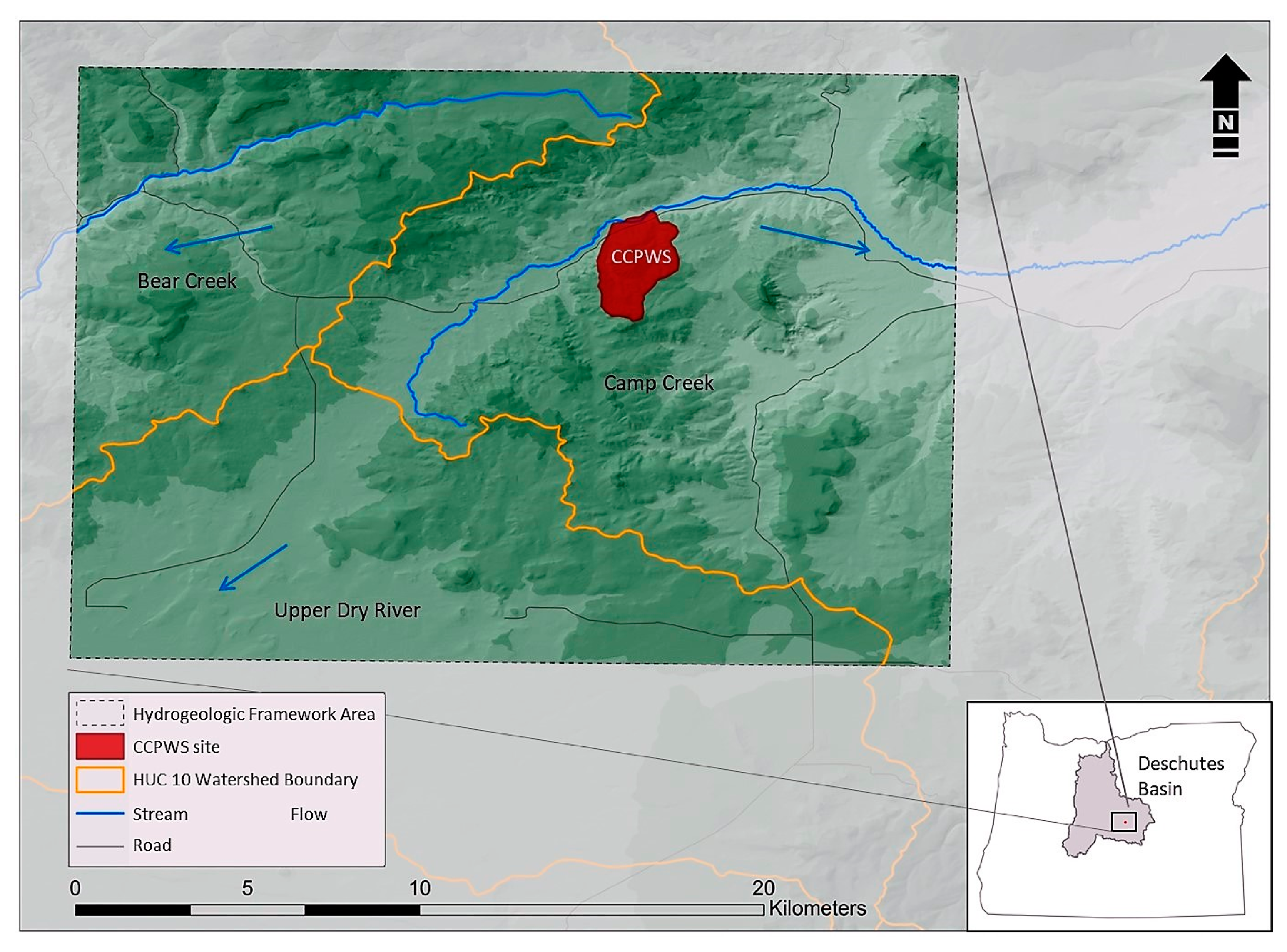
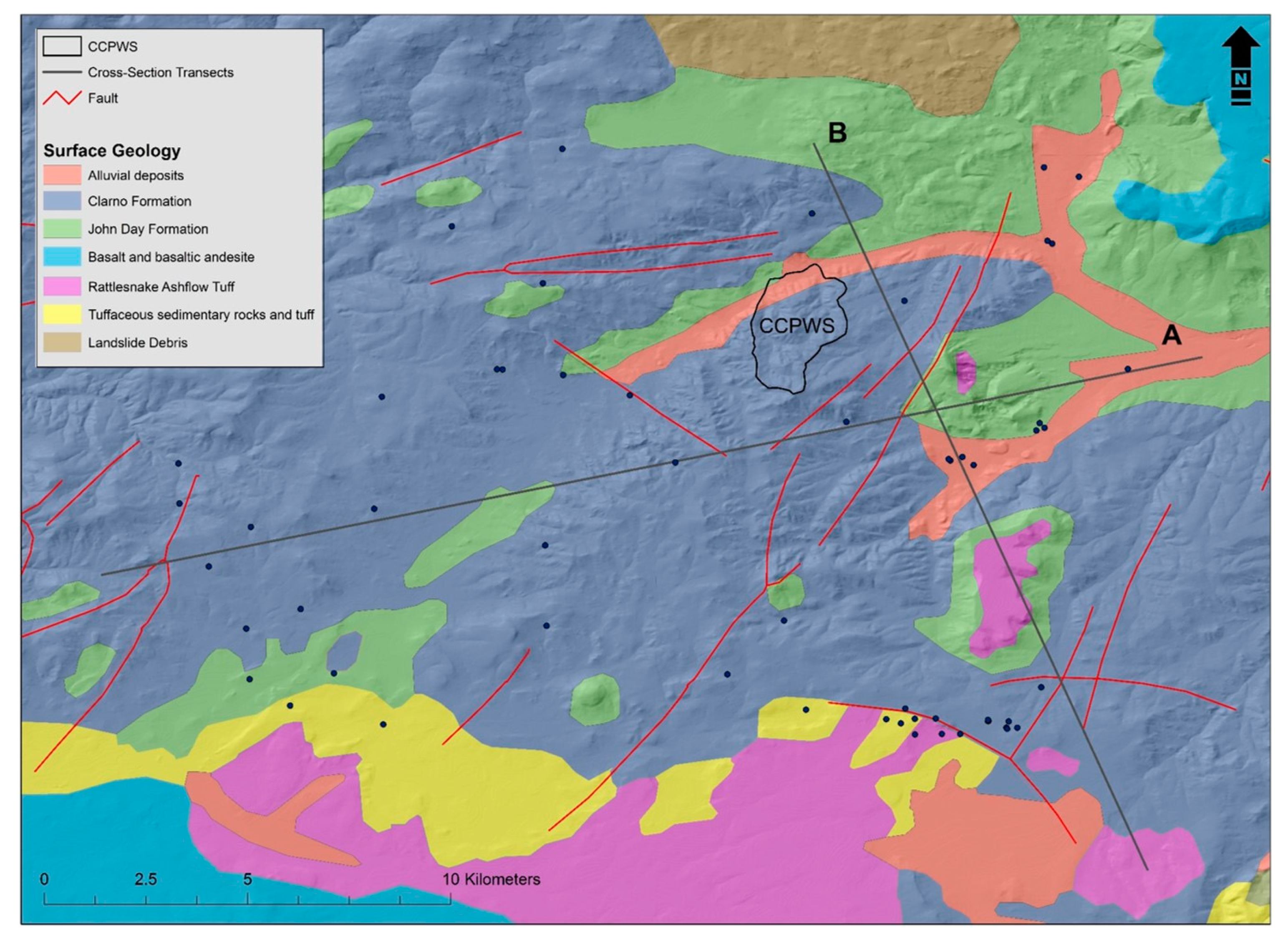
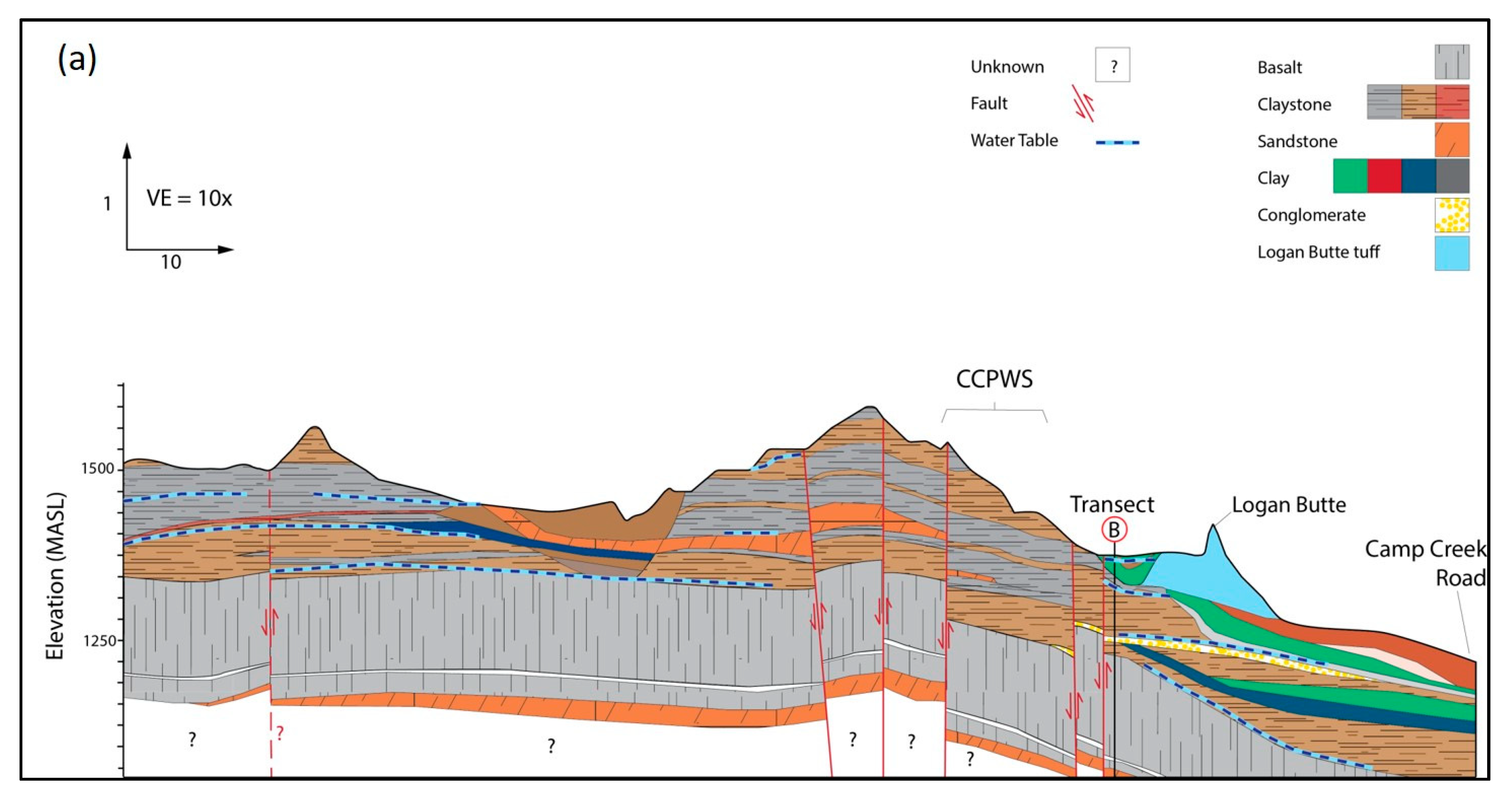
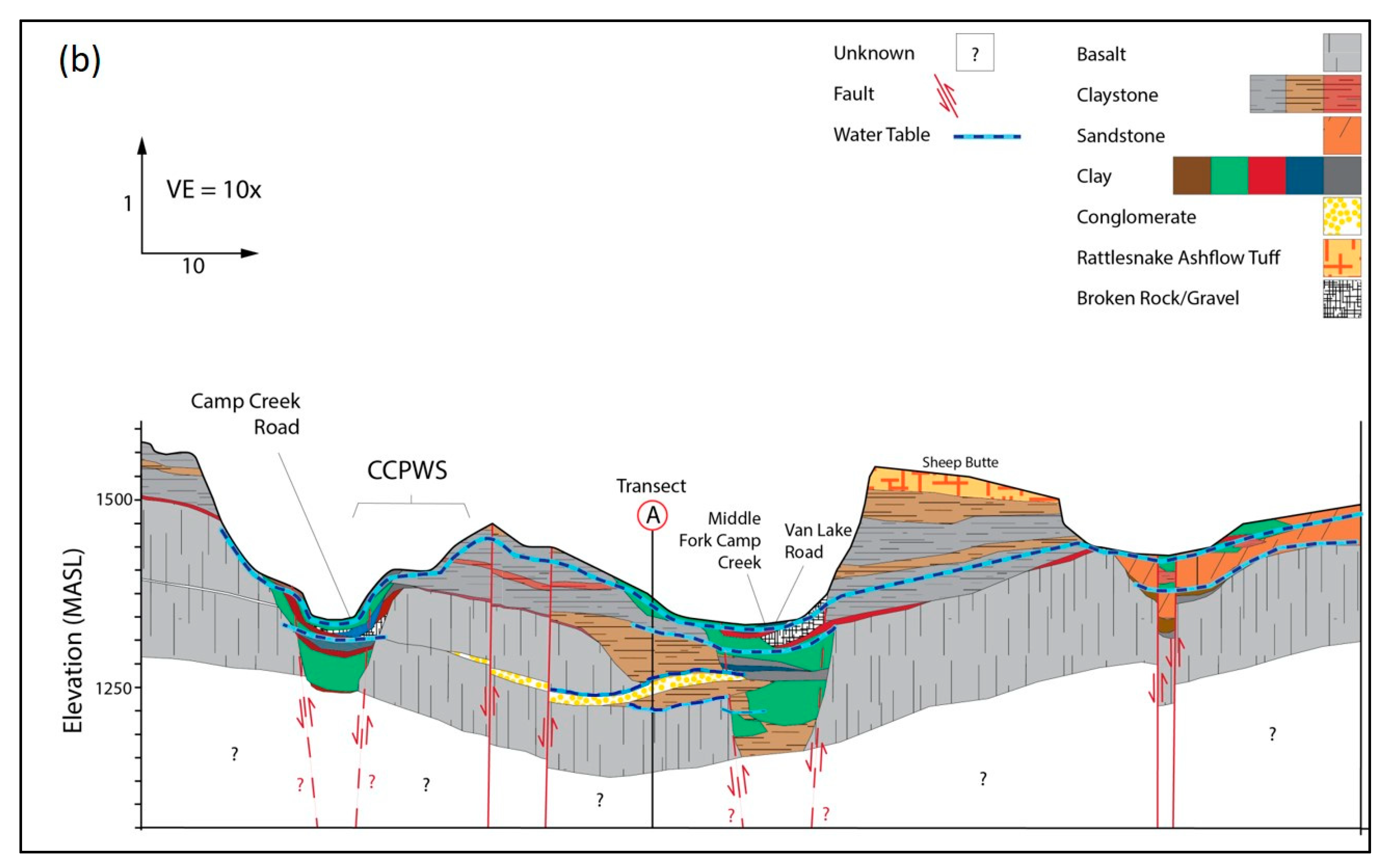
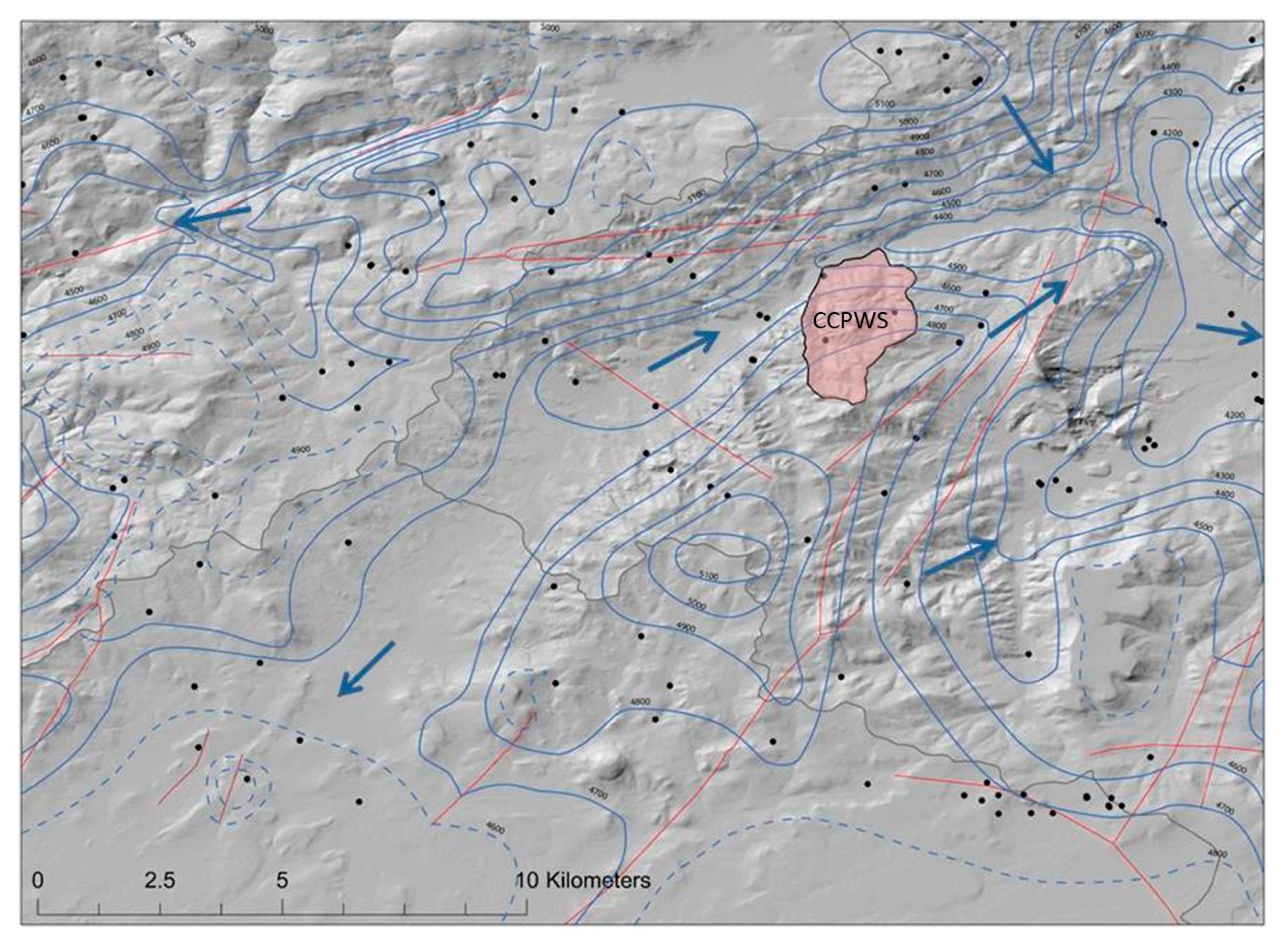
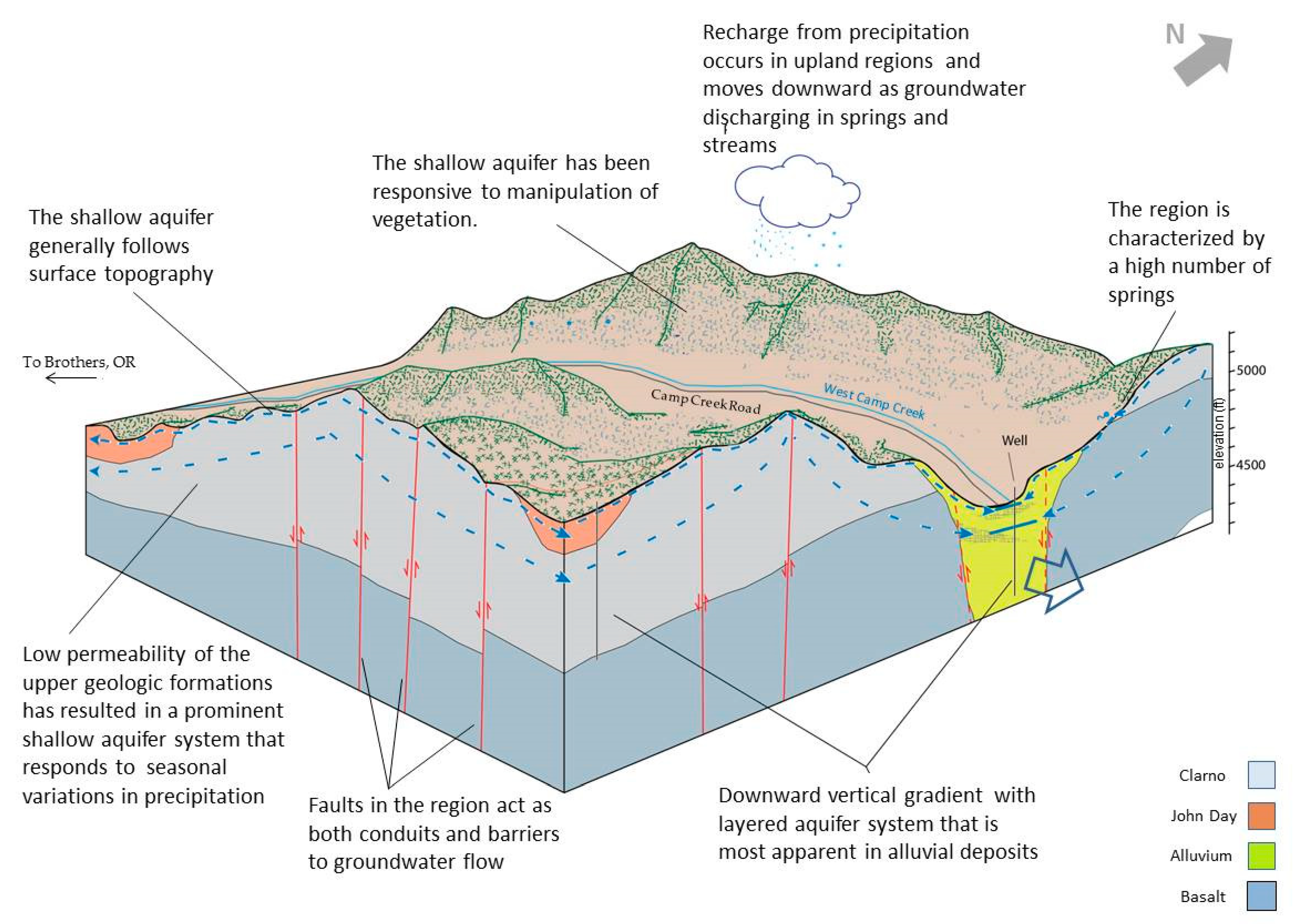
© 2019 by the authors. Licensee MDPI, Basel, Switzerland. This article is an open access article distributed under the terms and conditions of the Creative Commons Attribution (CC BY) license (http://creativecommons.org/licenses/by/4.0/).
Share and Cite
Caruso, P.; Ochoa, C.G.; Jarvis, W.T.; Deboodt, T. A Hydrogeologic Framework for Understanding Local Groundwater Flow Dynamics in the Southeast Deschutes Basin, Oregon, USA. Geosciences 2019, 9, 57. https://doi.org/10.3390/geosciences9020057
Caruso P, Ochoa CG, Jarvis WT, Deboodt T. A Hydrogeologic Framework for Understanding Local Groundwater Flow Dynamics in the Southeast Deschutes Basin, Oregon, USA. Geosciences. 2019; 9(2):57. https://doi.org/10.3390/geosciences9020057
Chicago/Turabian StyleCaruso, Phil, Carlos G. Ochoa, W. Todd Jarvis, and Tim Deboodt. 2019. "A Hydrogeologic Framework for Understanding Local Groundwater Flow Dynamics in the Southeast Deschutes Basin, Oregon, USA" Geosciences 9, no. 2: 57. https://doi.org/10.3390/geosciences9020057
APA StyleCaruso, P., Ochoa, C. G., Jarvis, W. T., & Deboodt, T. (2019). A Hydrogeologic Framework for Understanding Local Groundwater Flow Dynamics in the Southeast Deschutes Basin, Oregon, USA. Geosciences, 9(2), 57. https://doi.org/10.3390/geosciences9020057





